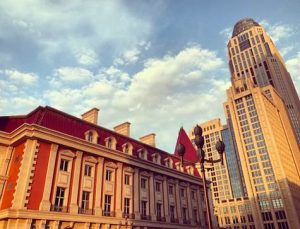
China’s industrial transformation
As we bid farewell to the Year of the Rooster and raise a toast to the Year of the Dog, our Asia analyst and Portfolio Manager, Camilla Cecil, draws on her recent experience of living in Hong Kong and company visits to mainland China to explain just how much the Chinese economy is changing.
The rebalancing of China’s economy is well under way. For six years now, services and consumption have had a bigger share of GDP than manufacturing and construction. Everywhere you travel in China you can see evidence of this transformation.
The Annual Economic Working Committee’s 2017 objectives focused on the three Ds: de-leveraging, de-stocking and de-capacity. The Committee’s ‘three key battles’ for 2018 aim to tackle pollution, poverty and financial risk. The game of whack-a-mole continues; fresh challenges continue to emerge in this vast economy, but much progress has been made. President Xi’s overarching aims for stability, avoiding systematic risks and the shift to a growth phase that prizes higher quality over quantity are encouraging.
Polluters under the hammer
The three Ds led to supply-side reforms addressing the manifestations of ‘old China’: excess capacity, inventories and leveraged state-owned enterprises (SOEs) concentrated in manufacturing, construction and commodities.
82% and 55% respectively of the multi-year reduction targets for coal and steel had been reached by late 2017. Working-day restrictions in the coal sector eliminated overtime, and meetings with companies confirmed instances of bank lending being prohibited, factory floor space contractions and electricity being switched off to inefficient plants. There were stories, too, of inspectors turning up and using environmental and safety regulations impose closures or require intentionally unaffordable refurbishments.
In the city of Zibo, once responsible for about a quarter of China’s ceramic output (mainly floor and wall tiles), capacity has reduced by 70% and more than 150 companies have closed. Management suggested environmental and safety standards were more stringent than in Italy!
Transition from old China to new China
These reforms are politically fuelled as well as forward-looking. Pollution is not compatible with a superior quality of life for China’s residents with rising incomes. President Xi outlined his vision for China at the 19th Communist Party Conference in October 2017 and referred to the environment 89 times, versus only 70 mentions of the economy.

The historically-steeped Tianjin, near Beijing, on a rare blue sky day (May 2017) Picture by Camilla Cecil
Last year, Beijing became the first city in China to rely on clean energy. Previously, a blue-sky selfie on the Beijing Wall would have been more likely during state visits from foreign officials when nearby power plants were traditionally switched off. Encouragingly, pollution in Northern China was at the lowest level in 15 years last month.
Tackling poverty by creating new industry jobs
China is looking ahead for sources of demand as well as tackling supply. Companies are motivated to invest; tax breaks and government financing are available in certain sectors. This has spurred investment in automation, innovation, ‘Made in China 2025’ (moving up the value chain), medicine, AI and electric vehicles (EVs). Automation should help offsets demographics issues, with China’s working-age population actually in decline from 2013. China is now the world leader in EV penetration (40% of global sales) and is spending more on R&D than the EU (on track to surpass the US this year) while patent applications are up significantly over the past year.
Districts have had to transform as production has been relocated to lower-cost parts of Asia. Government funds have been set aside to support social stability and the re-training and relocation of redundant employees. In Zibo, for example, a green-energy incubator and high-tech industrial park have been constructed to shift the region towards innovation rather than manufacturing.
As the US turns more protectionist, China is opening up to its neighbours. The One Belt One Road initiative will enable the export of some ‘old China’ excess resources and skills, improve trade, and move forward globalisation and financial integration. The programme encompasses over 60 countries, 63% of the global population and a third of global GDP.
Consumption
Affluent households are the fastest-growing consumer group and are driving a premiumisation trend in China. This links into the need to shift towards higher value-add, innovation and services. The majority of the only-child generation in urban areas are on the property ladder and are often well supported by two parents and four grandparents.
This tech-savvy cohort has driven e-commerce and enabled China to leapfrog the West in many areas. McKinsey reports that China represents 42% of the global e-commerce market: it has led in the shift from cash to digital payments and in online food retail, where e-commerce companies in China have cooperated with incumbent retailers as opposed to eroding the profits of both formats.
The IMF forecasts that 84% of the increase in middle-class spending will come from Asia (ex Japan) up to 2030. Across the region and overseas, this has supported consumer staple and discretionary categories – sectors that have served James Hambro & Partners well over the past eight years. Tracking a number of consumer and corporate metrics offers us a helpful gauge of the overall health of the economy.
Regulatory crackdown on financial risk
In time, regulators will need to tackle the stock of debt to supplement existing efforts to reduce the flow of new debt. Addressing local government fiscal deficits and tightening up on the activity of banks and wealth management firms, is underway. Thus far, the central bank has supported the local banks by providing them with liquidity. Meanwhile, property purchase and land acquisition restrictions have been put in place to deter speculation despite low inventory levels (even in lower Tier cities).
Corporates in good health
It is worth noting that earnings growth of China’s listed, audited companies continues to be resilient. Corporates have reported impressive turnarounds in free cash flow over the past 18 months (including in overcapacity sectors), capital expenditure discipline is evident, and debt as a percentage of earnings (or equity) has been reducing since 2013. This has fed through to an improvement in bank balance sheets. Meanwhile, valuations are supportive, access to the markets has improved due to financial reform, and stock-connect programmes and international investors are still underweight. With global interlinkages rising, knowledge of this market should inform our understanding of the opportunities in Western markets, in addition to offering exciting opportunities in its own right.
China could not sustain its recent history of near double-digit annual growth. A controlled slowdown was essential. Pulling on the reins may unnerve investors, and will if financial or environmental reforms are too heavy-handed or de-stabilising. Monitoring the property sector and lending discipline will also be important. The size of the economy (strong sides to offset weak sides) should smooth headline numbers and bide time. China has many tools that it can use to attain its overarching aim of stability. It is a managed economy, capital controls are in place, domestic savings rates are high and retail bank deposits are stable. The debt is owed internally, denominated in a more flexible, local currency – and there are trillions of dollars in reserves (not to mention US Treasuries, as President Xi reminded President Trump recently!).
We watch the country closely, but for now it is hard not to feel positive about the huge changes taking place.
Camilla Cecil
Posted 22 February 2018
You should not act on the content of this market commentary without taking professional advice. Opinions and views expressed are personal and subject to change. No representation or warranty, express or implied, is made of given by or on behalf of the Firm or its partners or any other person as to the accuracy, completeness or fairness of the information or opinions contained in this document, and no responsibility or liability is accepted for any such information or opinions.
The value of an investment and the income from it can go down as well as up and investors may not get back the amount invested. This may be partly the result of exchange rate fluctuations in investments which have an exposure to foreign currencies. Fluctuations in interest rates may affect the value of your investment. The levels of taxations and tax reliefs depend on individual circumstances and may change. You should be aware that past performance is no guarantee of future performance.
Image: iStock
